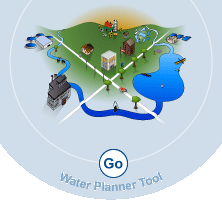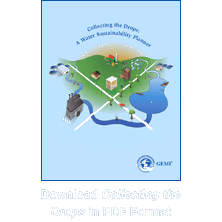
|
|
Module 2Water Management Risk Assessment |
| Aquifer |
2. There are several ways that water is withdrawn from the watershed. Water is withdrawn from surface water (rivers and streams) from groundwater through production wells or through the collection and use of precipitation. Please enter the sources of water withdrawn from the watershed by the supplier or privately owned water supply system (surface water, groundwater, precipitation).
Type answer here:
| Groundwater |
3. What is the average annual rainfall at your facility? Using your internet browser, type in “average annual rainfall” for your facility location. Another link that has reference information is http://www.worldclimate.com.
Type answer here:
| 9 inches per year |
4. What is the available water per person per year (m3/person/year)? Review information related to your specific watershed by using the following links:
http://multimedia.wri.org/watersheds_2003/index.html;
http://waterdata.usgs.gov.
Please compare the figure for your watershed to the following thresholds to define scarcity.
Risk Criteria
□ 1 = > 10,000 to 20,000 cubic meters per person per year
□ 2 = > 5,000 to 10,000 cubic meters per person per year
□ 3 = > 2,000 to 5,000 cubic meters per person per year
□ 4 = 1,000 to 2,000 cubic meters per person per year
□ 5 = < 1,000 cubic meters per person per year
| Importance: |
|
(1-5, 1=lowest, 5=highest) |
Table 5 is an example of the results which includes a list of the general questions and responses given, the average risk ranking for the risk category answered and a summary of the highest risks to lowest risks in descending order. Table 5 provides the risk score entered, the question number the score relates to and a link to GEMI member case examples that may prove helpful to the user in identifying options for reducing risk.
Table 5. Sample Results of Questionnaire
Collecting the Drops:
Evaluation
Watershed
General Information
1. Enter watershed that facility relies on for its water supply.
Aquifer2. What are the sources of water from the watershed withdrawn by the supplier or privately owned water supply system (surface water, groundwater, recycled)?
Groundwater3. What is the average annual rainfall at your facility? Using your internet browser, type in “average annual rainfall” for your facility location.
9 inches per yearAverage Ranking 4
Relevant Information GEMI Member Case Example 1 GEMI Member Case Example 2 GEMI Member Case Example 3 GEMI Member Case Example 4 GEMI Member Case Example 5
|
|
|
GEMI |
Module 1: Water Use and Impacts | Module 2: Water Management Risk Assessment | Module 3: Case Examples and Links
Home | Preface | Acknowledgements | Introduction | Calculators | Reference
All Contents © GEMI Inc., All Rights Reserved.




